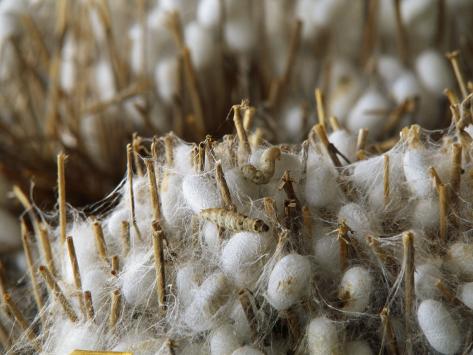Above: Silkworm Cocoons
Silk is one of the most popular fibres in the world. It is highly sought after due to its exquisite draping capabilities, incredible strength, lustre, dyeing properties and elasticity. The production of silk is know as sericulture and it was developed by the Chinese around 3000 BC. The fibre is harvested from silk worms and the most luxurious silks are produced by silk worms which live on a diet of mulberry leaves. It takes around 3000 silkworms eating over 100 kilograms of mulberry leaves to produce just 1 kilogram of silk. These silkworms are then steamed to death while still inside their chrysalises before their silk can be harvested.
The above method of silk production is thought by some to be inhumane and a contemporary fashion issue. This belief, alongside cost, performance and bio technical considerations, has led to the development of silk alternatives. These silk alternatives include:
- Ahimsa ('non violence') silk which first appeared in 1991 and is produced by harvesting the silk from the cocoons after the silkworms have metamorphosised and moved on. Thus, Ahimsa silk is believed to be a more humane method of silk production.
- Viscose and cuprammonium which are common types of rayon. They are made from regenerated wood pulp and exhibit many of the advantageous qualities of silk - such as breathability, absorbency and exquisite drape - at a fraction of the cost.
- Aramids which are nylon fabrics first developed by the DuPont company in 1961. These fibres have been developed to be even stronger than silk and they are used for bullet proof jackets, cloth for sails and cables for suspension bridges.
While it is interesting to research silk alternatives, I think that pure, traditional silks are the best option for my own womenswear collection and hence, that is what I will use.
Bibliography
Imitations
of Silk, Antiques Digest, viewed 04/05/2012, .
Fountain, H., 2011, The Reinvention of Silk, The Ney York
Times, New York, viewed 04/05/2012, <
http://www.nytimes.com/2011/03/08/science/08silk.html?pagewanted=1>.
2010, Silk Production and Humane Alternatives, Vegetarian Times, viewed 04/05/2012,.
2010, About Us, Ahimsa Silks, viewed 04/05/2012, < http://www.ahimsasilks.com/aboutus1.htm>.
2011, ‘Rayon: The Affordable Silk
Alternative’, Partial Coverage,
weblog, viewed 04/05/2012, .

No comments:
Post a Comment